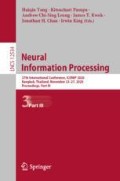Abstract
Advertising recommendation is crucial for many Internet companies because it largely affects their business income, and click-through rate (CTR) plays a key role in it. Most of the current CTR prediction models pay less attention to the feature importance before feature interaction. Besides, during bilinear feature interaction (BI), these models simply use hadamard product or inner product and implicitly introduce unnecessary feature order noise. In this paper, we propose a model called Feature Aware and Bilinear Feature Equal Interaction Network (FaBeNET). On the one hand, it can be aware of the feature importance and keep original feature as many as possible through the Squeeze-and-Excitation Residual Network (SE-ResNet); On the other hand, it assigns an interaction matrix to each feature, so the BI can be equally and effectively learned by the combination of hadamard product and inner product. On this basis, a deep neural network is used to learn higher-order feature interaction. Experiments show that FaBeNet achieves performance 0.7919 AUC and 0.4581 Logloss, which is better than other models, such as the DCN, xDeeepFM, and FiBiNET.
Access this chapter
Tax calculation will be finalised at checkout
Purchases are for personal use only
References
Cheng, H.T., Koc, L., Harmsen, J., et al.: Wide & deep learning for recommender systems. In: Proceedings of the 1st Workshop on Deep Learning for Recommender Systems, pp. 7–10 (2016)
Graepel, T., Candela, J.Q., Borchert, T., et al.: Web-scale Bayesian click-through rate prediction for sponsored search advertising in Microsoft’s Bing search engine. Omnipress (2010)
He, X., Pan, J., Jin, O., et al.: Practical lessons from predicting clicks on ads at Facebook. In: Proceedings of the Eighth International Workshop on Data Mining for Online Advertising, pp. 1–9 (2014)
Davidson, J., Liebald, B., Liu, J., et al.: The YouTube video recommendation system. In: Proceedings of the Fourth ACM Conference on Recommender Systems, pp. 293–296 (2010)
Beel, J., Gipp, B., Langer, S., et al.: Research-paper recommender systems: a literature survey. Int. J. Digit. Libr. 17(4), 305–338 (2016). https://doi.org/10.1007/s00799-015-0156-0
Kleinbaum, D.G., Dietz, K., Gail, M., et al.: Logistic Regression. Springer, New York (2002)
Rendle, S.: Factorization machines. In: 2010 IEEE International Conference on Data Mining, pp. 995–1000. IEEE (2010)
Juan, Y., Zhuang, Y., Chin, W.S., et al.: Field-aware factorization machines for CTR prediction. In: Proceedings of the 10th ACM Conference on Recommender Systems, pp. 43–50 (2016)
Xiao, J., Ye, H, He, X., et al.: Attentional factorization machines: learning the weight of feature interactions via attention networks. arXiv preprint arXiv:1708.04617 (2017)
Zhang, W., Du, T., Wang, J.: Deep learning over multi-field categorical data. In: Ferro, N., et al. (eds.) ECIR 2016. LNCS, vol. 9626, pp. 45–57. Springer, Cham (2016). https://doi.org/10.1007/978-3-319-30671-1_4
Guo, H., Tang, R., Ye, Y., et al.: DeepFM: a factorization-machine based neural network for CTR prediction. arXiv preprint arXiv:1703.04247 (2017)
He, X., Chua, T.S.: Neural factorization machines for sparse predictive analytics. In: Proceedings of the 40th International ACM SIGIR Conference on Research and Development in Information Retrieval, pp. 355–364 (2017)
Wang, R., Fu, B., Fu, G., et al.: Deep & cross network for ad click predictions. In: Proceedings of the ADKDD 2017, pp. 1–7 (2017)
Lian, J., Zhou, X., Zhang, F., et al.: xDeepFM: combining explicit and implicit feature interactions for recommender systems. In: Proceedings of the 24th ACM SIGKDD International Conference on Knowledge Discovery & Data Mining, pp. 1754–1763 (2018)
Huang, T., Zhang, Z., Zhang, J.: FiBiNET: combining feature importance and bilinear feature interaction for click-through rate prediction. In: Proceedings of the 13th ACM Conference on Recommender Systems, pp. 169–177 (2019)
Hu, J., Shen, L., Sun, G.: Squeeze-and-excitation networks. In: Proceedings of the IEEE Conference on Computer Vision and Pattern Recognition, pp. 7132–7141 (2018)
He, K., Zhang, X., Ren, S., et al.: Deep residual learning for image recognition. In: Proceedings of the IEEE Conference on Computer Vision and Pattern Recognition, pp. 770–778 (2016)
Linsley, D., Scheibler, D., Eberhardt, S., et al.: Global-and-local attention networks for visual recognition. arXiv preprint arXiv:1805.08819 (2018)
Duchi, J., Hazan, E., Singer, Y.: Adaptive subgradient methods for online learning and stochastic optimization. J. Mach. Learn. Res. 12(Jul), 2121–2159 (2011)
Kingma, D.P., Ba, J.: Adam: a method for stochastic optimization. arXiv preprint arXiv:1412.6980 (2014)
Srivastava, N., Hinton, G., Krizhevsky, A., et al.: Dropout: a simple way to prevent neural networks from overfitting. J. Mach. Learn. Res. 15(1), 1929–1958 (2014)
Acknowledgment
This work was supported by the National High Technology Research, Development Program of China (No. 2018YFB1703500), the Shanghai Innovation Action Project of Science and Technology (No. 19511105502), and the Fundamental Research Funds for the Central Universities.
Author information
Authors and Affiliations
Corresponding author
Editor information
Editors and Affiliations
Rights and permissions
Copyright information
© 2020 Springer Nature Switzerland AG
About this paper
Cite this paper
Luo, L., Chen, Y., Liu, X., Deng, Q. (2020). Feature Aware and Bilinear Feature Equal Interaction Network for Click-Through Rate Prediction. In: Yang, H., Pasupa, K., Leung, A.CS., Kwok, J.T., Chan, J.H., King, I. (eds) Neural Information Processing. ICONIP 2020. Lecture Notes in Computer Science(), vol 12534. Springer, Cham. https://doi.org/10.1007/978-3-030-63836-8_36
Download citation
DOI: https://doi.org/10.1007/978-3-030-63836-8_36
Published:
Publisher Name: Springer, Cham
Print ISBN: 978-3-030-63835-1
Online ISBN: 978-3-030-63836-8
eBook Packages: Computer ScienceComputer Science (R0)

